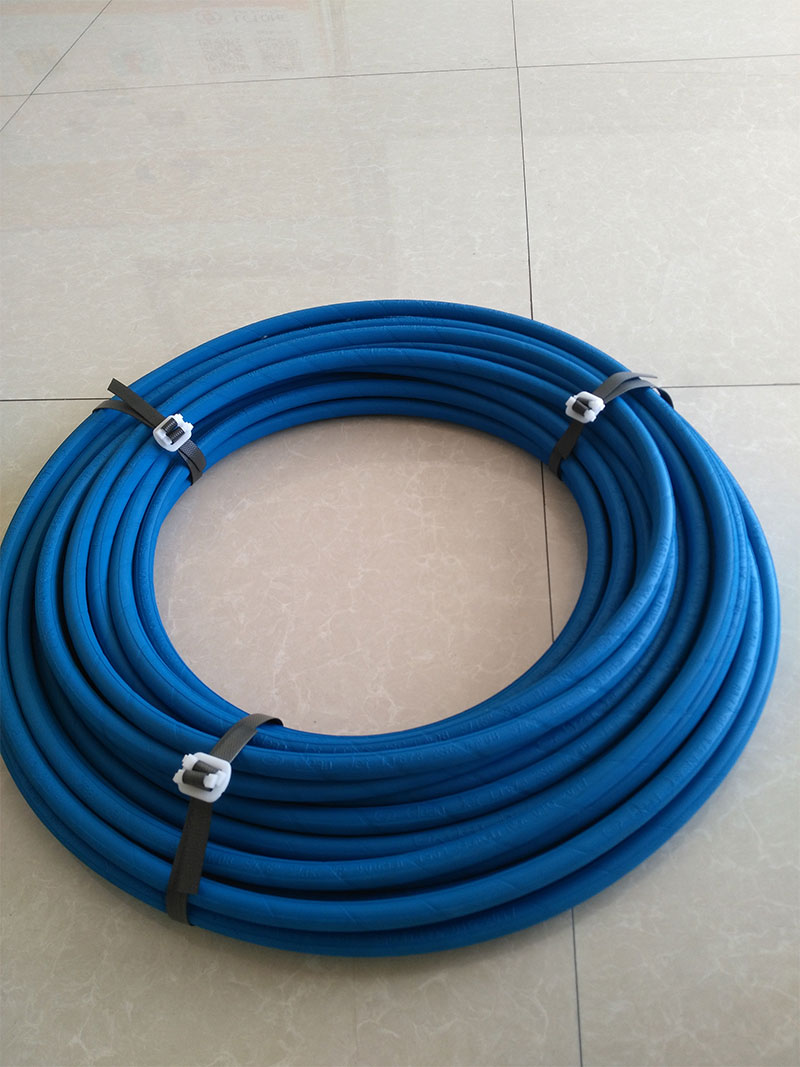2025-05-22 16:29:24
Full analysis of hydraulic oil pipe selection
DN6-51 hydraulic oil pipe is a flexible pipeline for conveying high-pressure media in hydraulic systems, with an inner diameter range of 6mm to 51mm, suitable for scenarios with different flow requirements. The product adopts a multi-layer structure design, with an inner layer of oil resistant rubber, a middle layer of steel wire weaving or winding reinforcement layer, and an outer layer of protective rubber. This structure endows it with excellent pressure resistance, flexibility and anti-aging performance, and can work stably at -40 ℃ to+100 ℃.
2、 Technical parameters and performance indicators
Stress tolerance
Working pressure range: Depending on the number of layers of steel wire, the working pressure can reach 28MPa to 100MPa.
Blasting pressure: usually 2-3 times the working pressure to ensure safety under extreme working conditions.
Bending radius and flexibility
Minimum bending radius: proportional to the inner diameter, for example, the minimum bending radius for DN6 model is about 60mm, while for DN51 model it needs to be greater than 720mm.
Dynamic adaptability: Allow a length variation of -4% to+2% in the connection of vibrating or moving parts to avoid rupture caused by stress concentration.
Media compatibility
Suitable for media such as mineral oil, water-based hydraulic oil, ethylene glycol solution, etc., but avoid contact with castor oil or ester based liquids.
3、 Application scenarios and industry adaptation
construction machinery
In equipment such as excavators and loaders, DN6-51 hydraulic oil pipes are used to connect hydraulic pumps and actuators, withstanding high-pressure pulses and frequent bending.
Industrial Automation
In injection molding machines, die-casting machines and other equipment, this type of oil pipe is used to transmit high-pressure oil to ensure the stability of precision movements.
agricultural machinery
In equipment such as tractors and harvesters, oil pipes need to adapt to sandy and muddy environments, and their wear-resistant outer layer can extend their service life.
Ship and Aviation
In servo systems or aviation hydraulic devices, strict certification of oil pipes is required to ensure reliability in extreme environments.
4、 Installation and maintenance specifications
Installation precautions
Avoid twisting: During installation, keep the oil pipe naturally bent to prevent loose or broken joints.
Reasonable bending radius: The distance between the bending point and the joint should be greater than 1.5 times the outer diameter to avoid additional stress.
Fixing and protection: Use pipe clamps to fix the oil pipe, avoid contact with sharp objects, and reduce friction damage.
Regular maintenance requirements
Appearance inspection: Check the surface of the oil pipe monthly for cracks, bulges, or wear, with a focus on inspecting the joints.
Pressure test: Conduct a pressure test every six months to ensure that the oil pipe is leak free at rated pressure.
Replacement cycle: According to the frequency of use, it is recommended to replace it every 3-6 years to avoid aging and malfunction.
5、 Selection and matching suggestions
Pressure matching
Select the tubing model based on the maximum working pressure of the system, for example, for a system with a working pressure of 35MPa, tubing with a burst pressure of ≥ 105MPa should be selected.
Relationship between flow rate and inner diameter
The selection of inner diameter needs to balance flow velocity and pressure loss. For example, DN10 oil pipe has a flow velocity of about 1m/s at a flow rate of 0.5L/min, which is suitable for low-pressure return oil pipelines.
Compatibility of connectors
It is necessary to match threaded (such as DKOL, DKOS) or flange (such as SFL, SFS) joints to ensure that the sealing form is consistent with the system requirements.
6、 Common Problems and Solutions
tubing leak
Reason: Loose joints, aging seals, or damaged oil pipes.
Solution: Tighten the joint, replace the sealing ring, or replace the oil pipe as a whole.
Tubing bulge
Reason: Overpressure use or damage to the steel wire layer.
Solution: Reduce work pressure or replace oil pipes with higher pressure levels.
Oil pipe hardening
Reason: Long term high temperature or medium corrosion leads to aging of the rubber layer.
Solution: Replace the high-temperature or corrosion-resistant oil pipe


Leave a Comment